For more than a century, the change of the calendar from September to October has truly signaled the actual arrival of autumn for baseball fans across North America, despite the autumnal equinox occurring more than a week earlier. The World Series looms large over the hearts and minds of fans from coast to coast. The marathon 162-game season race has been run, and as they approach the finish line, the leaders are clearly visible.
“By far, the best moment of my big league career was when I caught the last out at the World Series.”
– Cal Ripken, Jr.
October has historically been the month of the year when heroes of the game have been made. Legends are born during the championship games with stellar on-field performances. Dreams of hitting the game-winning or series-clinching home run or striking out the last batter for the final out exist in the minds of thousands of youths throughout their childhood and remain an unspoken desire for those who transition to a professional baseball career. In recent major league baseball seasons, November has become the month of post-season diamond feats as the expanded playoffs extended play beyond October.
“You never forget the feeling of not getting to the World Series. Yes, it sticks with you.”
– Ryne Sandberg
The World Series has always held the attention of baseball fans whether they have a cheering stake in the game or not. Seeing the two best teams facing each other and wondering who among the most unlikely players will rise to the enormity of the occasion and etch their names in the lore of the Fall Classic with a clutch hit or overcoming a pressure-packed situation by striking out the league’s best slugger with the bases loaded hold even the most casual of baseball fans’ attention. For fans, remembering these moments and engaging in discussion about which of them is the greatest always leads to debate. However, for some, it is not enough to savor them just in memory.
“The best possible thing in baseball is winning the World Series. The second-best thing is losing the World Series.”
– Tommy Lasorda
A trip to the Hall of Fame Museum in Cooperstown, New York is an eye-opening experience for any visitor. For those enamored with the game’s artifacts, a visit can awaken desires to collect game treasures and catapult them into the lifelong and expensive pursuit of building a collection.
Collecting World Series artifacts is cost-prohibitive for average baseball fans. Some of the most expensive objects stem from the participants in the games in the form of uniforms, equipment, and championship awards such as trophies, pendants and rings which can carry price tags of five, six or even seven digits. There are more reasonable items from these games that are within reach of collectors with less available discretionary financial resources.
Baseball programs represent a lower-cost investment alternative to the typical vintage sports collectible. “In many cases, programs cost far less than a trading card of a popular player from the same year,” wrote Sal Barry, “and can give you more enjoyment.[1]”
Harry Chadwick is noted as the man who conceived a system of scorekeeping in the 1860s that paved the way for tracking player performance statistics.[2] His system of notation[3] has stood the test of time and provides sportswriters, team managers and fans with the ability to measure player and team performance. It was not until entrepreneur Harry M. Stevens attended a Columbus (Ohio) Senators baseball game in 1887 that one of the best baseball collectibles was born. Though scorecards were already in use throughout baseball at the time, Stevens recognized a financial opportunity for baseball team owners to sell advertising space on the cards. Stevens’ idea was to purchase the rights from the team to sell the scorecards for the games. For the sum of $500, Stevens struck a deal and set out to sell the advertising space and to get the cards printed. After selling his first block of advertising, Stevens had a 140-percent return on his investment before printing or selling a single scorecard. Stevens began expanding his service to other ballparks around the country.[4] He is responsible for what became one of the most figuratively and literally colorful pieces of baseball history and one of the most affordable and available collectibles.
Though not a typical mainstream collectible, baseball scorecards along with game programs have their own niche among collectors. Contemporary scorecards are printed in a more generic fashion as rosters are far too fluid throughout the season. Printing costs and the waste associated with changing rosters are not fiscally sound. The more generic-oriented cards are more challenging to pinpoint to a specific game if left unscored. However, vintage pieces such as from the 1940s tend to be more easily pinpointed to a specific week of the season, depending on the team that produced the scorecard. World Series pieces, however, are far more desirable due to the nature of the games’ importance, historic nature, and roster specificity.[5]
In addition to condition, there are many factors that can impact or drive the collector value of a World Series scorecard including the age, the specific game, outcome, teams involved, and player heroics as well as if the piece is scored. Many World Series scorecards are easily fetching 4-digit values on the collector market, inching several of these items out of reach for everyday collectors. Depending upon the historical magnitude of the game, collector demand increases, driving the values skyward. For example, “a scorecard of Don Larsen’s perfect game in the World Series on October 8, 1956, is worth more than most other programs,” Jeff Figler wrote in 2018. “The same would hold true with the program of Jackie Robinson’s debut on April 15, 1947.[6]”
Another niche area of scorecard collecting exists in the realm of military or service team baseball. With the flow of the game’s top-tier, youthful talent into the armed forces and onto service baseball teams, scorecards from these games are quite collectible. Unlike major league games where thousands of cards were produced, the smaller venues and one-off games saw far smaller numbers printed, which leads to greater scarcity.

Wartime service game scorecards have created a considerable increase in interest in the last few years that is likely attributable to their affordability combined with the presence of Hall of Fame players including Ted Williams, Joe DiMaggio, Phil Rizzuto, Stan Musial, and Billy Herman, who all served and played on service teams during the war. By 1944, the largest assemblage of the game’s stars was serving in the Hawaiian Islands and playing for teams such as the Aiea Naval Hospital “Hilltoppers,” Pearl Harbor Submarine Base “Dolphins,” Aiea Naval Receiving Barracks “Maroons,” Naval Air Station (NAS) Kaneohe Bay “Klippers,” and the 7th Army Air Force “Flyers.” The major leagues were populated with players beyond their prime, others who were brought up the big leagues before gaining the necessary experience and those who were deemed unfit for military service, resulting in a diminished quality of play on the field; but the island of Oahu was the epicenter for baseball star power.
For those attending wartime games on the islands, preprinted scorecards were available. While these pieces tend to be extremely scarce, collector interest is relatively weak due to the lack of knowledge of the leagues, games, teams, and the players on the rosters. However, there were important games that drew substantial crowds due to the caliber of the players on the rosters and the historic nature of the contests themselves.


For decades, Oahu was a hotbed for baseball with several leagues that included civilian and military clubs operating before the Pearl Harbor attack. In 1942, some former professional players who were serving began to trickle onto the island and onto their respective units’ baseball teams. The following year saw a greater increase leading to one club, the Pearl Harbor Submarine Base Dolphins, dominating other service teams and civilian clubs in the various leagues. By 1944, the Army responded in kind and emptied their West Coast bases of talent to build a super club to take the fight to the Navy with the 7th Army Air Force team based at Hickam Field. With major league talent including Mike McCormick, Walt Judnich, Dario Lodigiani, John “Long Tom” Winsett, Joe Gordon, Red Ruffing and Joe DiMaggio, the club was a force to be reckoned with. In addition to the major league stars, the 7th’s minor leaguers truly propelled the Flyers to the top of the standings. Former San Francisco Seals first baseman Ferris Fain led the field, claiming a league batting crown. Former Seal hurler Al Lien was a dominant force on the mound, with future Yankee backstop Charlie Silvera handling the pitchers from behind the plate.


Unlike the Army, who amassed its talent on the 7th AAF squad, the Navy had their share of stars spread throughout multiple bases. Walt Masterson, Jimmy Gleeson, Al Brancato, Joe Grace, Bob Harris, Rankin Johnson, and Mo Mozzali led the Pearl Harbor Sub Base. Johnny Lucadello, Barney McCosky, and Eddie Pellagrini were at Aiea Receiving Barracks. Tom Ferrick, Johnny Mize, Hugh Casey, and Wes Schulmerich were stationed at NAS Kaneohe; and Vern Olsen, George Dickey, and Pee Wee Reese were at the Aiea Naval Hospital.
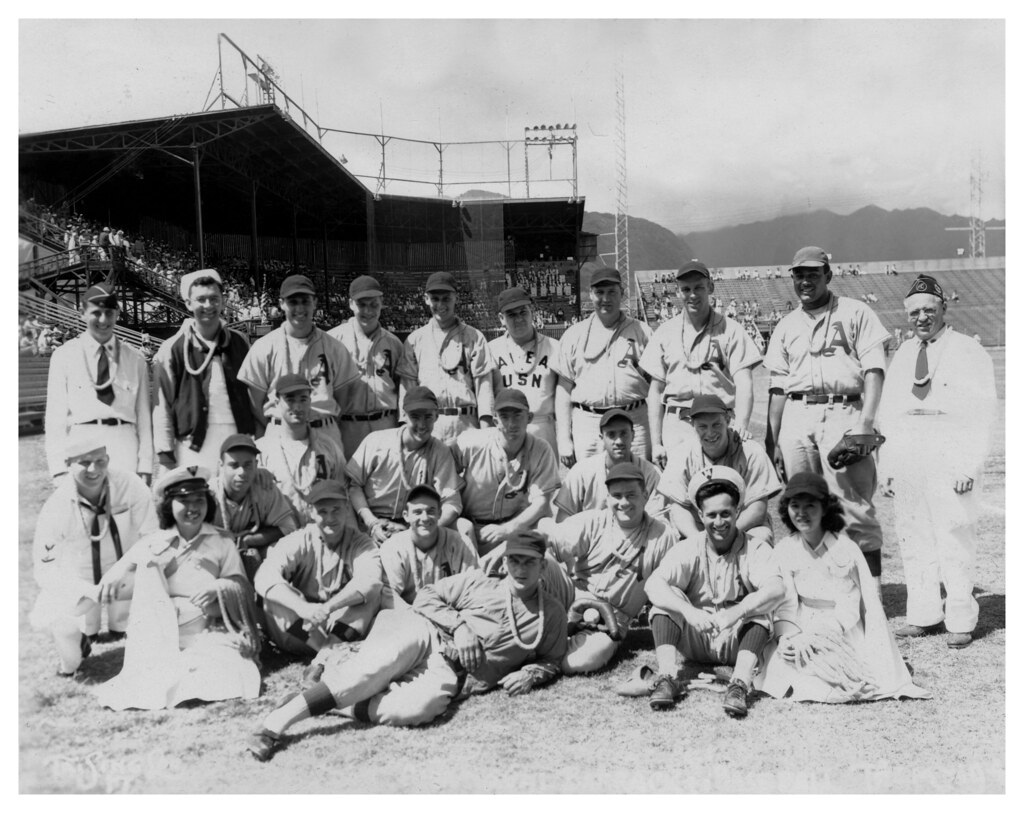

By the end of regular season play, the 7th captured the championship hardware, with the already-planned inter-service All-Stars championship looming for September and October. It was billed as the Servicemen’s World Series, a seven-game contest that pitted baseball stars from the Army against those of the Navy and was played solely at military facilities for the benefit of service personnel. Planning for the series began late in the summer and speculation began to swirl about prospective players being dispatched to the islands for the series. Three major league stars serving elsewhere in the Navy – Dom DiMaggio and Phil Rizzuto, both in Melbourne, Australia and Bob Feller, who was serving aboard the battleship USS Alabama – were the favorite contenders for the Series discussed in the local papers. However, by mid-September, only Rizzuto and DiMaggio were en route to Oahu. The operational necessities of the USS Alabama kept Feller out of contention for the Navy team.[7]
The best-of-seven series was set to commence on September 22 at the Navy’s home, Furlong Field, at Pearl Harbor (for Games 1, 5 and 7) and would extend into October with games hosted at Hickam Field (Games 2 and 6), Redlander Field at the Schofield Barracks (Game 3), and Naval Air Station Kaneohe Bay (Game 4) to ensure that service personnel throughout the island had opportunities to experience the excitement in person. Prior to the opening game, all the fields underwent some form of expanded seating construction to increase capacity for the expected crowds.


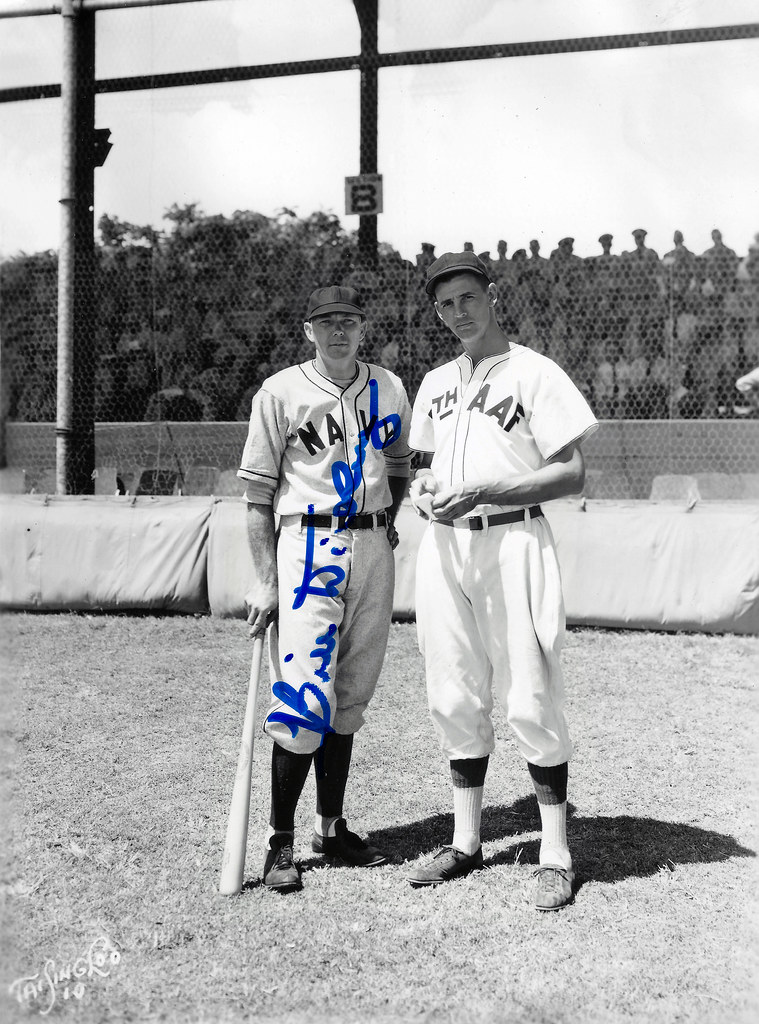
Riding the wave of the 7th AAF’s regular season success in defeating the Oahu Navy clubs, Army leadership built their All-Star roster around 17 players drawn from the Flyers. The remainder of the club consisted of players pulled from other area Army commands including the Schofield Barracks. The Navy, however, pulled out all the stops in loading their lineup. With the arrival of Rizzuto and DiMaggio from Australia, the already stacked Navy All-Stars featured a lengthy list of nearly 40 former major and minor leaguers and semi-pros, outnumbering the Army by 11 players.
Recognizing the need to unify their personnel, the Navy played two warmup games, including an intra-squad tilt, leading up to the opening game of the Series. With three future Hall of Fame enshrinees filling positions on the Navy’s opening day starting lineup, the Navy was hoping to turn the tables on the Army’s dominance. Recognizing the comparatively lopsided Navy advantage, local sportswriters favored the Navy to take the series. “Today is the day of the opening of the Service World Series out at Furlong Field,” Red McQueen wrote in The Honolulu Advertiser. “If for no other reason than to stick out the ol’ neck so that some Army boys can chop it off, we’re going out on the proverbial limb with a call on the outcome of the classic,” McQueen continued. “The Navy in six or less games is our guess. Pitching is 80 to 90 percent of the battle and the Tars have it.”[8]
Further contributing to the Navy’s edge was the absence of one of the Army’s and the game’s greatest stars. Staff Sergeant Joe DiMaggio spent the better part of the 1944 season dealing with ulcers, which limited his availability for the 7th AAF. With the continuation of his health issues, the Yankee Clipper was wholly unavailable for the Servicemen’s World Series.[9]

Navy All-Stars:
| Rate/Rank | # | Player | Position | Former |
|---|---|---|---|---|
| 12 | Jim Adair | P | Semi-Pro | |
| SM3/c | 26 | Arnie “Red” Anderson | P | Chattanooga (SOUA) |
| TM2/c | 10 | Norman Gene “Pee Wee” Atkinson | C | Semi-Pro |
| 9 | John “Johnny” Berry | RF | U of Oregon/Semi-Pro | |
| EM2/c | 4 | Tom Bishop | SS | Semi-Pro |
| SK2/c | 17 | Albert (Al) Brancato | 3B | Athletics |
| 16 | Jim Carlin | LF | Phillies | |
| Sp(A)1/c | 27 | Hugh Casey | P | Dodgers |
| LT | 28 | Bill Dickey | Mgr. | Yankees |
| Sp(A) 1/c | 15 | George “Skeets” Dickey | C | White Sox |
| CSp(A) | 11 | Dom DiMaggio | CF | Red Sox |
| 31 | Gordon Evans | LF | Charleston (MATL) | |
| Hank Feimster | P | Danville-Schoolfield (BIST) | ||
| Sp(A) 1/c | 18 | Marvin Felderman | C | Cubs |
| Sp(A) 1/c | 31 | Tom Ferrick | P | Indians |
| Sp(A) 1/c | 28 | Joseph “Joe” Grace | RF | Browns |
| Sp(A) 2/c | 29 | Jack Hallett | P | Pirates |
| Sp1/c | 24 | Robert A. “Bob” Harris | P | Athletics |
| PhM3/c | 20 | John “Hubie” Jeandron | 2B | Port Arthur (EVAN) |
| YN1/c | 23 | A. Rankin Johnson | P | Athletics |
| 6 | Dave Liebold | Bat Boy | ||
| CSp (A) | 5 | Johnny Lucadello | 2B | Browns |
| CsP(A) | 26 | Walt Masterson | P | Senators |
| Sp(A) 1/c | 3 | Barney McCosky | CF | Tigers |
| Sp(A) 2/c | 32 | Johnny Mize | 1B | Giants |
| TM1/c | 13 | Maurice “Mo” Mozzali | CF | Semi-Pro |
| Sp(A) 1/c | 30 | Vern Olsen | P | Cubs |
| 21 | Sal Recca | 3B | Norfolk (PIED) | |
| CSp (A) | 34 | Harold “Pee Wee” Reese | SS | Dodgers |
| CSp (A) | 2 | Phil Rizzuto | SS | Yankees |
| 26 | Lynwood “Schoolboy” Rowe | P | Tigers | |
| LT | 30 | Wes Schulmerich | Asst. Mgr. | Twin Falls (PION) |
| 14 | Ken “Ziggy” Sears | C | Yankees | |
| CEM | 19 | Oscar Sessions | P | |
| 29 | Eddie Shokes | 1B | Syracuse (AA) | |
| 1 | Vincent Smith | C | Pirates | |
| 22 | Virgil Trucks | P | Tigers | |
| S1/c | 27 | Johnny Vander Meer | P | Reds |
Army All-Stars:
| Rank | # | Player | Former |
|---|---|---|---|
| Rank | # | Player | Former |
| Corp. | 13 | Renaldo “Rugger” Ardizoia | Kansas City (AA) |
| Corp. | 10 | James Ashworth | Helena (CSTL) |
| Lt. | 16 | John “Johnny” Beazley | Cardinals |
| Lt. Col | 30 | Joseph D. “Joe” Clarke | Semi-Pro |
| Bill DeCarlo | Minneapolis (AA) | ||
| Corp. | 27 | Carl DeRose | Amsterdam (CAML) |
| Cpl. | 1 | Bob Dillinger | Toledo (AA) |
| S/Sgt. | 4 | Joe DiMaggio | Yankees |
| 11 | Hank Edwards | Indians | |
| 19 | Eddie Erautt | Hollywood (PCL) | |
| S/Sgt. | 7 | Ferris Fain | San Francisco (PCL) |
| Sgt. | 18 | Edward Funk | Federalsburg (ESHL) |
| 15 | Sid Gautreaux | Memphis (SOUA) | |
| Vincent Genegrasso | Semi-Pro | ||
| Pvt. | 28 | Hal Hairston | Homestead Grays |
| Sgt. | 3 | Walter “Wally” Judnich | Browns |
| Corp. | 22 | Cornel George “Kearny” Kohlmeyer | Tyler (ETXL) |
| 12 | Don Lang | Kansas City (AA) | |
| Pfc. | 9 | Will Leonard | Oakland (PCL) |
| Pfc. | 25 | Al Lien | San Francisco (PCL) |
| Sgt. | 2 | Dario Lodigiani | White Sox |
| Corp. | 5 | Myron “Mike” McCormick | Reds |
| 23 | Dick Molberg | Semi-Pro | |
| 21 | Don Schmidt | Semi-Pro | |
| Corp. | 24 | William “Bill” Schmidt | Sacramento (PCL) |
| SSGT | 29 | John Shumbres | |
| Corp. | 8 | Charlie Silvera | Wellsville (PONY) |
| 1st Lt. | 20 | Tom Winsett | Dodgers |
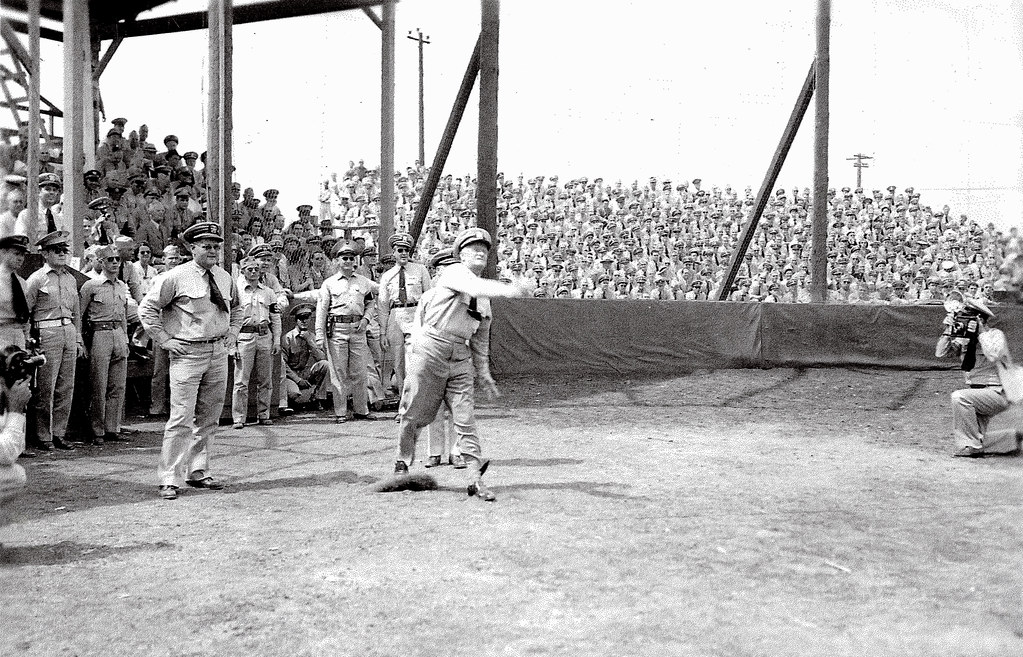

Game 1
Shortly after 8:00 a.m., servicemen began arriving at the Furlong Field gates more than six hours before the 2:30 p.m. game time[10] in eager anticipation for the start of the Series. With all games set to be played on area military installations, the games were Inaccessible to the civilian population; however, Honolulu radio station KGMB was on site to broadcast the game and the entire Series, with rebroadcasts set for distribution to the Armed Forces Radio Service throughout the Pacific Theater of Operations.[11]
Army bats were silenced from the first pitch through the top of the ninth, stymied by Navy hurler Virgil “Fire” Trucks. Though Trucks pitched a four-hit shutout, the Army managed to reach base seven times. In addition to solid Navy fielding stranding five of the opposition’s runners, Trucks fanned six, winning the opening game, 5-0. The Tars touched Don Schmidt for 10 singles while Trucks helped his own cause with a pair of hits, one of them pushing a run across the plate.




Game 2
Shifting venues to the more friendly surroundings of Flood Field at Hickam Army Air Field, the Army sought to even the Series, sending former San Francisco Seal Al Lien to the mound. The Navy countered with Johnny “Double-No-Hit” Vander Meer for the second game. The two clubs matched run for run in the first and fifth innings, leaving the score knotted at two heading into the eighth. Vander Meer held the Army scoreless after the Navy plated the go ahead run in the top of the eighth inning, leaving the Navy with a 3-2 advantage. In the top of the ninth, Dom DiMaggio walked with one out followed by a Reese single and was plated on a rocketed comeback through the box off the bat of Vinnie Smith that Lien deflected. As Gordon fielded the ball, DiMaggio sped around and scored while Smith reached first safely. With two on and one out, Lien was lifted for reliever Eddie Funk, but the Navy bats were still hot.
Manager Bill Dickey sent Ken Sears to bat in Vander Meer’s spot. After Sears flied out, Rizzuto walked. Joe Grace came to the plate with two outs and the bases loaded and promptly dispatched a souvenir to the fans beyond the right field fence for a grand slam. Funk coaxed McCosky to foul out to the catcher to end the inning, but the damage was done. Navy manager Lieutenant Bill Dickey sent Hugh Casey in to lock down the 8-2 victory and put the Navy up two games to none.

Game 3
After taking Sunday, September 24, off, the teams traveled to the Schofield Barracks to face off at Redlander Field. Don Schmidt hoped to silence the Navy’s guns as he took the mound for the Army in the third game, opposed by Tom Ferrick. After setting down Rizzuto, who struck out looking, any confidence Schmidt may have felt soon vanished with Joe Grace’s one-out double. McCosky singled to right field and Grace scored from second. McCosky scored another run on Mize’s single to center before Schmidt got the final two outs of the frame.
In the bottom of the second inning, the Army cut the lead in half on a Judnich home run. Heading to the top of the fourth, the Army saw an unfamiliar sight on the scoreboard, a 3-2 lead. The Army had pulled ahead after two outs in the bottom of the third. Dillinger singled to left field and swiped second base. Mike McCormick singled and drove Dillinger across the plate to tie the game. Edwards reached first on a Lucadello error. McCormick scored on Judnich’s single, leaving the Navy down by a run. The Army’s lead was short-lived due to a series of Army miscues.
Lucadello grounded to third but reached first as first baseman Fain dropped Lodigiani’s throw. Catcher Sid Gautreaux let one of Schmidt’s pitches get by him, allowing Lucadello to advance to second. After DiMaggio whiffed for the first out and Reese walked, Vinnie Smith singled to left field to drive Lucadello home, tying the game, 3-3.
The score remained knotted until the top of the twelfth. With Schmidt still in for the Army, Ken Sears broke the tie with a 360-foot bomb to right field with one out. In the bottom of the frame, Navy reliever Casey, back on the hill for his third inning, looked to be in trouble after Fain singled off second baseman Lucadello’s glove. Casey hunkered down to get Gordon out swinging for the first out. Lodigiani hit into a fielder’s choice, forcing Fain out at second. Pinch hitter Don Lang grounded to short, giving the Navy a 4-3 victory and a three-game lead.
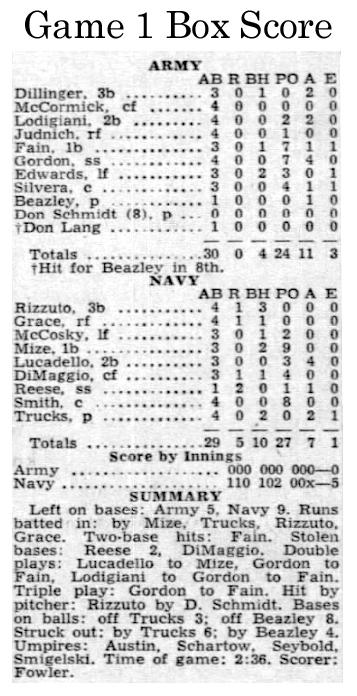

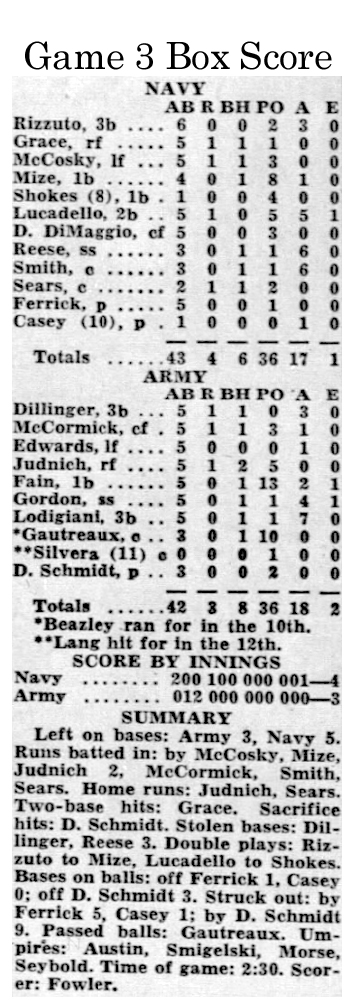

Game 4
The Navy juggernaut was seemingly unstoppable as the Series shifted 20 miles northeast of Pearl Harbor to Kaneohe Bay Naval Air Station for the fourth game. The Navy was set on putting the series to bed, though discussions were already underway to play the full seven games for the benefit of the serviceman spectators. The Navy went back to the pitching well to bring Game 1 starter Virgil Trucks to the mound in hopes of a repeat performance. Winsett pinned the Army’s hopes upon Johnny Beazley to keep the Navy off the base paths.
Kaneohe Bay’s ball field was engulfed by more than 10,000 sailors as Trucks took the mound and set down the first three in order, fanning one. In the bottom of the opening frame, Beazley did not have the same luck. Rizzuto hit the Army pitcher for a leadoff single, but Grace seemed to swing the momentum in Beazley’s favor by grounding into a double play. McCosky walked on four straight and reached second on wild pitch. With two down and a runner in scoring position, Beazley pitched to slugger Johnny Mize, who took him deep to straight away center field for a two-run shot.
Leading 4-0 after four innings, Navy loaded the bases with no outs. Beazley was lifted for Eddie Erautt, who walked DiMaggio and Reese to force in two runs. Smith singled and drove in another pair before Trucks struck out and Rizzuto grounded into a double play to end the carnage. Navy was ahead, 8-0, and well on its way to securing the series-clinching game. Trucks had a comfortable lead and was dominating Army hitters, allowing just four hits and on his way to another shutout victory.

Not ready to lay down their arms, Army bats came to life in the top of the sixth. Leading off, Judnich singled to right field. The league batting champion, Fain, strode to the plate and drove Trucks’ offering 340 feet on a line shot over the right field wall. Joe Gordon followed Fain’s lead and powered a line drive over the left field wall and suddenly, the Army was back in the game. Trucks walked Lodigiani and uncorked a wild pitch to Army backstop Gautreaux allowing Dario to move to second. The big catcher was called out on strikes for the first out. Hitting for the pitcher Erautt, Don Lang whiffed for the second out and Trucks appeared to be working out his kinks. Bob Dillinger had other ideas and stroked a single to center field, scoring Lodigiani as the pressure on Trucks began to increase once again. McCormick worked the Navy pitcher for a free pass to load the bases with two outs, ending Trucks outing.
With “Schoolboy” Rowe taking over on the mound, Edwards singled and drove in Dillinger from second base. Rowe walked Judnich, filling the sacks with Army runners. With two outs and five runs already scored, Fain grounded to first for the final out, but the Army had narrowed the gap, trailing 8-5.
The Army manager sent former Homestead Grays hurler Hal Hairston to the mound to hold the Navy bats at bay and he promptly fanned Joe Grace to start the bottom of the sixth. McCosky grounded to short. Gordon mishandled the ball, rushed his throw to Fain at first and threw wide of the bag, allowing the runner to reach second. Mize singled next and drove in McCosky before Hairston worked out of the jam, but Navy now led 9-5.
Rowe set down the Army in order in the top of the seventh, but Hairston was unable to do the same in the bottom half. Reese led off with a single and Smith bunted him to second, then Rowe popped out to first. Rizzuto singled to score Reese, extending the Navy’s lead. In the last two frames, Judnich accounted for the Army’s last hit of the game as the Navy locked up their fourth straight win by a score of 10-5, and the Series crown.
With more than 56,000 service personnel attending the first four games, it was clear to leadership that the Servicemen’s World Series was a resounding success and a considerable morale boost to the troops stationed on Oahu. The decision was made to play the remaining three games on the schedule. Returning to the site of the opening game, Vander Meer was called upon to start for the Navy on Furlong Field’s mound for Game 5.

Game 5
Dickey began to change things with his lineup, insuring other players on the roster saw action in the Series. Rizzuto, who had been manning the hot corner throughout the first four games, was moved to second base, replacing Lucadello, and Al Brancato took over at third, making his initial appearance in the Series.
As Vander Meer continued his dominance over Army batters, the change in the lineup only seemed to improve Navy hitting. Lucadello’s 0-16 bat, now on the bench, was replaced by Brancato, who joined in the Tars’ hit parade. Navy batters touched Lien, Molberg, Hairston and Ardizoia for 12 runs on 10 hits while Vander Meer held Army bats to two runs on five hits. The Army’s defensive woes also continued into the fifth game as they tacked on three to the eleven errors committed over the first four games. The Furlong crowd of 16,000 saw yet another Navy win and the Army fans were left wondering if their boys were entirely outmatched with the 12-2 drubbing.

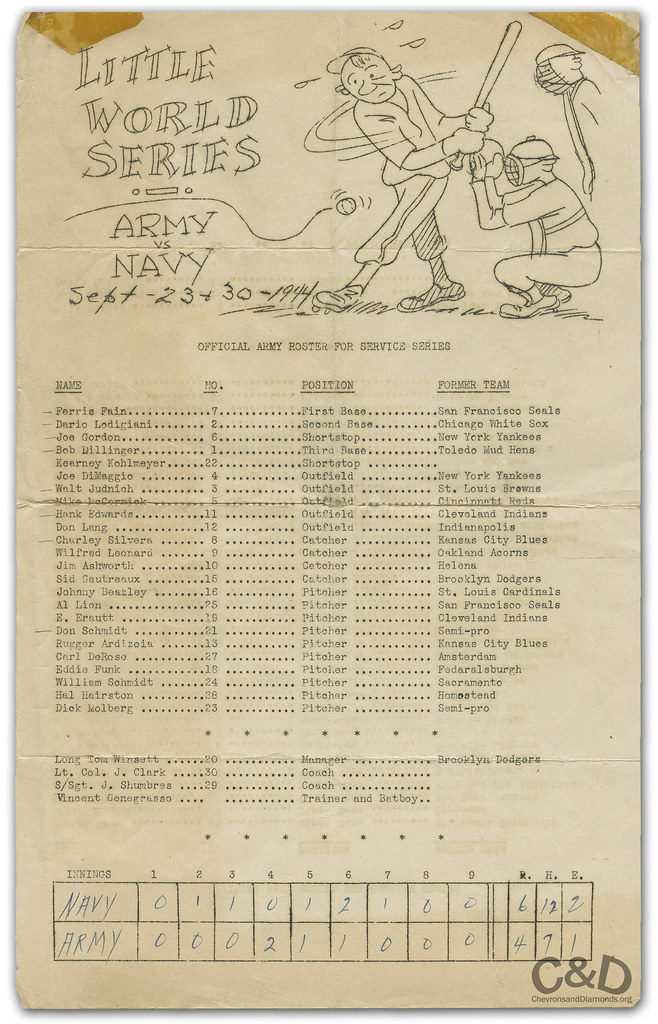
Game 6
The Series made its return to Hickam’s Flood Field for Game 6 as Winsett sent Don Schmidt back to the mound for his second series start. Former Pittsburgh Pirate hurler Jack Hallett made his rubber-toeing debut for the Navy.
Rizzuto got things going for the Navy in the top of the first as Schmidt could not find the strike zone with his initial four pitches. Gautreaux neutralized the leadoff baserunner when he gunned down “Scooter” as he attempted to steal second. Schmidt walked the next batter but coaxed DiMaggio to whiff and Mize ended the inning with a fly out to center. In the bottom of the inning, the Army took the lead when Dillinger reached on a Pee Wee Reese error. After McCormick’s failed bunt attempt, Dillinger accomplished what Rizzuto could not, swiping second. Hallett walked Edwards and Judnich to load the bases before Fain plated Dillinger on a fielder’s choice. Hallett struck out Gordon to end the inning with the Army out to an early lead.
In the third inning, the Navy finally got to Schmidt for two runs after Rizzuto singled with two outs and then stole second. Joe Grace kept things going, working Schmidt for a free pass. DiMaggio cleared the bases with a drive to right center but was out at third attempting to stretch his double to a triple.
Trailing Navy 2-1 and with two outs in the bottom of the third, Ferris Fain singled off Pee Wee Reese’s glove. Catcher Sears let one of Hallett’s pitches get by, allowing Fain to take second base. Gordon came to the plate with Fain in scoring position and two down, working the count full against Hallett before smashing the next pitch into the left field stands to put Army back on top, 3-2.

In the top of the fourth, left fielder Schoolboy Rowe lined a one-out double and was plated when Sears made amends for his third inning miscue by doubling to the right field corner. Brancato flied out to left field before Reese walked ahead of the pitcher’s spot in the order. Manager Bill Dickey called his own number to pinch hit for Hallett. With Reese and Sears on first and second, and perhaps intimidated by the legendary Yankee catcher at bat, Schmidt was called for a balk, moving the base runners up 90 feet. With both runners in scoring position, Schmidt coaxed Dickey into fouling to the third base side as Dillinger made the out to retire the side, leaving the score locked up at three runs each.
Masterson took over for Hallett, pitching one-hit ball through the sixth inning. In the top of the seventh, Dickey sent Jim Carlin to pinch hit for Masterson and he promptly singled to lead off the inning. After Rizzuto flied out to Gordon, Gautreaux misplayed a Schmidt pitch, allowing Carlin to move to second. Joe Grace singled and Carlin raced around third and broke for home. The relay from Lodigiani to home went to the backstop as Carlin scored and Grace advanced to second. Schmidt limited the damage to one run by working out of the jam.




Trailing 4-3, the Army answered. Tom Ferrick replaced Masterson on the hill and Don Schmidt greeted the relief pitcher with a single. Bob Dillinger bunted, pushing Schmidt to second. McCormick joined the fray and crushed a triple to deep left center, plating Schmidt to tie the game, 4-4.
In the eighth, Rowe singled and was sacrificed to second by new catcher Vinnie Smith. After a Brancato pop fly to short for the second out, Reese grounded to short and Rowe was caught trying to advance to third. Instead of getting the sure out at first, Gordon tossed to Dillinger, but Rowe scampered back to second, beating the throw. Still with two outs, Ferrick lined a single to left center, allowing Rowe to score and Reese to move to third on the throw home. With runners at the corners, Rizzuto executed a perfect bunt base hit that scored Reese, putting the Navy ahead, 6-4.

Army hitters managed a hit in each of the last two frames, but Ferrick and the Navy’s defense shut the Army down to extend their Series win streak to six.
Through the previous six games, the Navy held a 45-16 scoring advantage. Navy hurlers were stingy, allowing just 1.78 runs per game, proving Red McQueen’s pitching assessment and prediction to be correct. Meanwhile, their offense was relentless, averaging five runs per game. For the Army fans filing into the stands for Game 7, the outlook was bleak.



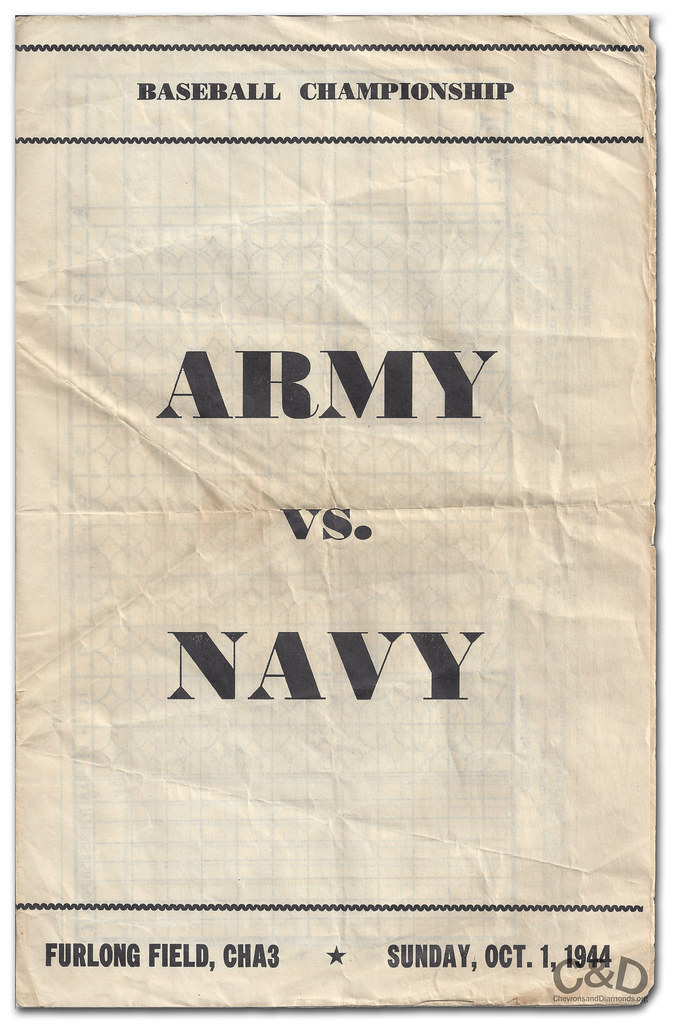
Game 7
For the seventh and final game, the Series moved to Furlong Field on Sunday, October 1, for a third visit to the Navy’s premier ballpark on the Island. Trucks made his third start of the series and was opposed by Carl De Rose. In the top of the first, Trucks set down the Army in order. DeRose retired Rizzuto and Grace, walked DiMaggio, then coaxed Rowe to hit a slow roller in front of the plate and be thrown out by catcher DeCarlo.
In the second frame, Don Lang homered off Trucks to right center with two outs. In the bottom half, Brancato led off with a single. With Brancato breaking for second, Reese lined a single into right field that allowed the leadoff man to reach third. Shokes popped out to second base for the first out. Bill Dickey hit a sharp grounder to Dillinger, who promptly threw home to get Brancato at the plate. Dickey lifted himself for Vinnie Smith and Virgil Trucks came to the plate with runners at first and second and two down. The Navy pitcher doubled down the right field line, scoring Reese. Rizzuto followed with a foul out.
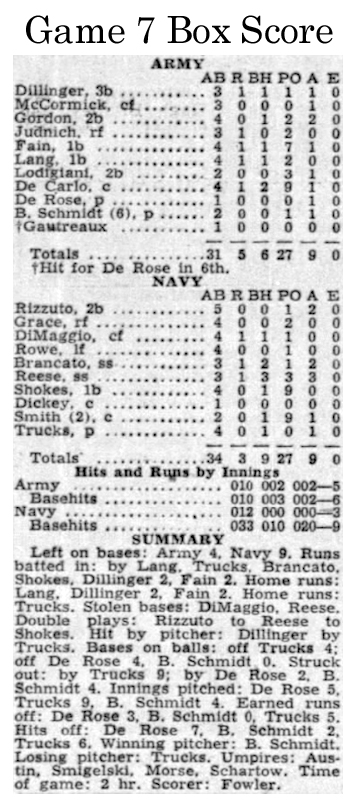
After Army was retired in order in the third, Dom DiMaggio hit a one-out single up the middle. The “Little Professor” swiped second before Rowe whiffed for the second out. Brancato sent a line drive to right field that drove in DiMaggio. DeRose walked Reese, pushing Brancato into scoring position. Shokes singled sharply up the middle, allowing Brancato to score and putting the Navy on top, 3-1. Army players and fans could not help but think, “here we go again,” as the Navy was once again pulling away.
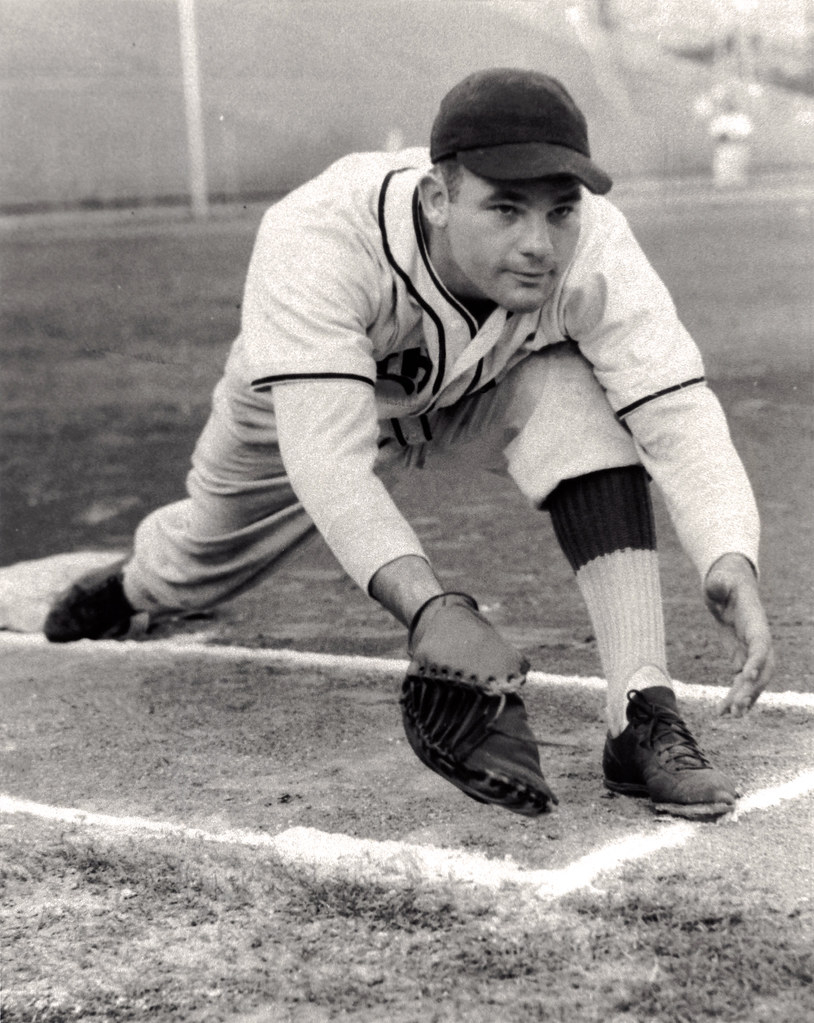
Trucks was unhittable in the fourth and fifth innings and DeRose only allowed one Navy hit in the fifth. In the top of the sixth, DeCarlo reached on a single to open the frame. With one out, Dillinger crushed a two-run bomb deep over the right field corner fence to even the game, 3-3. Trucks kept the Army hitless in the seventh and eighth innings while Bill Schmidt, who relieved DeRose after the sixth, allowed just two hits in the eighth.
The score was tied heading into the ninth. Gordon was set down on strikes by Trucks for the first out. Judnich worked the Navy pitcher for a walk before Fain strode to the plate. The Army first baseman and future American League batting champ promptly cracked the longest home run of the Series, sending a 390-foot bomb to the right center stands and putting his team ahead, 5-3.
Schmidt kept the Navy’s bats silenced for the bottom of the frame as Army players and fans had their moment to celebrate.

Navy first baseman Johnny Mize, former St. Louis Cardinals and New York Giants slugger, led all batters in average for the seven-game series, hitting .450; however, Phil Rizzuto captured the top position in hits with 12. [12] The Navy’s 48-21 scoring advantage would lead one to assume that the sailors crushed Army pitching with a multitude of home runs. However, with a total of 10 four-sackers, it was the Army lumber that sent more balls over the fences, with Ferris Fain and Joe Gordon each hitting a pair followed by Dillinger, Judnich and Lang with one apiece. For the Navy, Grace, Sears, and Mize accounted for all three of the Navy’s long balls.[13]

The Series was a monumental success as more than 100,500 troops attended the seven games, boosting morale throughout the island. With barely a moment to celebrate the series victory, Rizzuto and Dom DiMaggio departed Oahu immediately following the conclusion of Game 7. With plenty of service personnel stationed on other Hawaiian islands, plans were established in August by the military leadership to send two service All-Star squads for morale-boosting exhibition baseball to those islands. By late September, the decision was made to dispatch the Service World Series clubs to Maui, Hawaii and Kauai for Army, Navy, and Marine Corps personnel to enjoy high caliber baseball on the outer islands.[14]

Three days after the seventh game, the two service All-Star teams packed up and flew to Maui for a two-game series, played at the Kahului Fairgrounds on October 4th and 5th. On October 6, the teams faced off at Hoolulu Park, Hilo on the island of Hawaii. Nine days later, the final game in the four-game exhibition was played at Kukuiolono Park, Kauai on October 15.

Scorecards
While wartime service game scorecards are largely ignored by collectors, some of the game items do garner interest, with attention being given to the significant players present on the rosters. The Servicemen’s World Series pieces feature a handful of players who would later be inducted into the Baseball Hall of Fame. One name that draws collector interest, Joe DiMaggio, is listed on all seven game programs and scorecards and yet he was on the mainland by September 2, having departed Hawaii indefinitely in late August.[15] Acquiring all seven game pieces is not for the impatient. In more than a dozen years, we have seen only 15-20 total pieces from the entire Oahu series.
There are several factors that contribute to the challenges of locating these game pieces. With each of the games at or near capacity attendance, for every person to have a scorecard would mean that an average of 14,000 pieces were printed per game. In reality, the number for each game was reasonably less than the audience capacity. These estimates, while inexact, are much more scientific than determining the number of surviving copies. In the eight decades that have elapsed since the Series, it is impossible to number the pieces based upon market observation.
“Prior to the construction of concrete and steel stadiums beginning in the 1920s, ballparks often held less than 25,000 fans. Only some bought programs. Fewer saved them. Those who did may have passed them down, but others simply were discarded by family members because some of the earliest programs were actually simple scorecards that made no mention of the magnitude of what was taking place. They weren’t exactly considered keepsakes.[16]”
How many GIs maintained their scorecards after the game? A few of the pieces in our collection appear to have been sent home by the GIs. Of those that made it home, how many endured through home moves, storage failures or being discarded as “old stuff” by surviving children when estates were liquidated?
As of the writing of this article, Chevrons and Diamonds has acquired six of the seven game scorecards. In viewing our collection online, it appears to readers that we possess all seven pieces as we digitally replicated and altered our scored Game 6 piece in order to display a representation for Game 2. Both of the games played at Hickam Field used the same printing for both games (see Service World Series, 1944 – Hawaiian Islands).
All the Furlong Field games share a common design, with the game date being the only variation. The program and scorecard from Game 4 at NAS Kaneohe Bay is one of the most well-done pieces for a wartime service baseball game. Not only does the piece include the rosters, but the headshot photographs of the star players encompass five of the oversized pages. The final addition comes from the Redlander Field-hosted game and is the only one that includes scoring by the original owner.
Our collection also features two of the four pieces originating from the Maui, Hawaii, and Kauai games. Our hunt continues for the remaining pair as well as another Hickam piece to complete the full set.
[1] Berry, Sal; Lehman, Bert, “Sports programs are becoming an alternative for collectors who crave vintage material (https://sportscollectorsdigest.com/news/sports-programs-collectors),” Sports Collectors Daily, February 8, 2019 (accessed October 25, 2022).
[2] Schiff, Andrew, “Harry Chadwick, (https://sabr.org/bioproj/person/henry-chadwick)” Society of American Baseball Research (accessed October 22, 2022).
[3] “Baseball Basics: How to Keep Score (https://www.mlb.com/official-information/basics/score),” MLB.com, (accessed October 25, 2022)
[4] Cieradkowski, Gary, “218. Harry M. Stevens: The Visionary” (http://infinitecardset.blogspot.com/2016/04/218-harry-m-stevens-visionary.html),” The Infinite Baseball Card Set, April 29, 2015 (accessed October 22, 2022).
[5] Cresi, Frank; McMains, Carol, Baseball Programs and Scorecards (https://www.baseball-almanac.com/treasure/autont006.shtml), Baseball Almanac (accessed October 22, 2022).
[6] Figler, Jeff, “Baseball programs and scorecards (bit.ly/3N6WyRm),” Collectors Journal, April 23, 2018 (accessed October 25, 2022).
[7] “Projected Line-ups for the Service World Series,” The Honolulu Advertiser, September 15, 1944: p10.
[8] McQueen, Red, “Hoomalimali,” The Honolulu Advertiser, September 22, 1944: p12.
[9] Ibid.
[10] “Friday Stars the World Series,” Honolulu Star Bulletin, September 21, 1944: p.13
[11] Fowler, Chas., Ensign, “Yesterday’s Highlights,” The Honolulu Advertiser, September 15, 1944: p10.
[12] “Mize Leads Batters in Service World Series,” Honolulu Star-Bulletin, October 2, 1944: p.11.
[13] Bedingfield Gary. “Baseball in Hawaii during World War II,” Baseball in Wartime Publishing 2021.
[14] “Oahu All-Stars to Bring Baseball Headliners,” Hawaii Tribune-Herald, September 30, 1944: p4.
[15] “Late Sports,” Hawaii Tribune-Herald, September 30, 1944: p4.
[16] Mueller, Rich, “Vintage World Series Programs Offer Collector Challenges. (https://www.sportscollectorsdaily.com/hey-get-your-programs-here/),” Sports Collectors Daily, October 24, 2006 (accessed October 25, 2022).


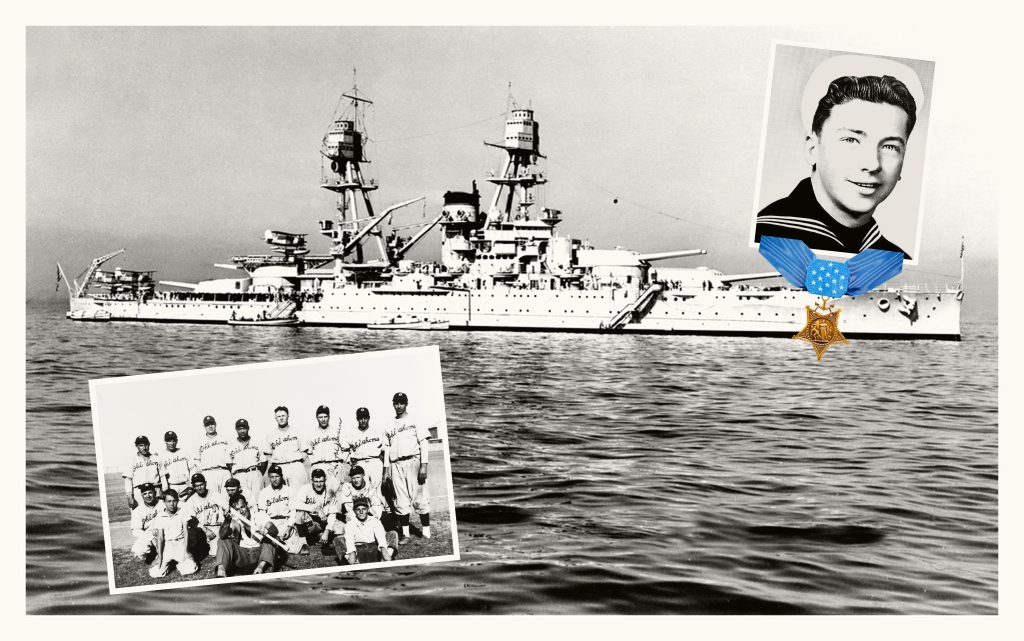
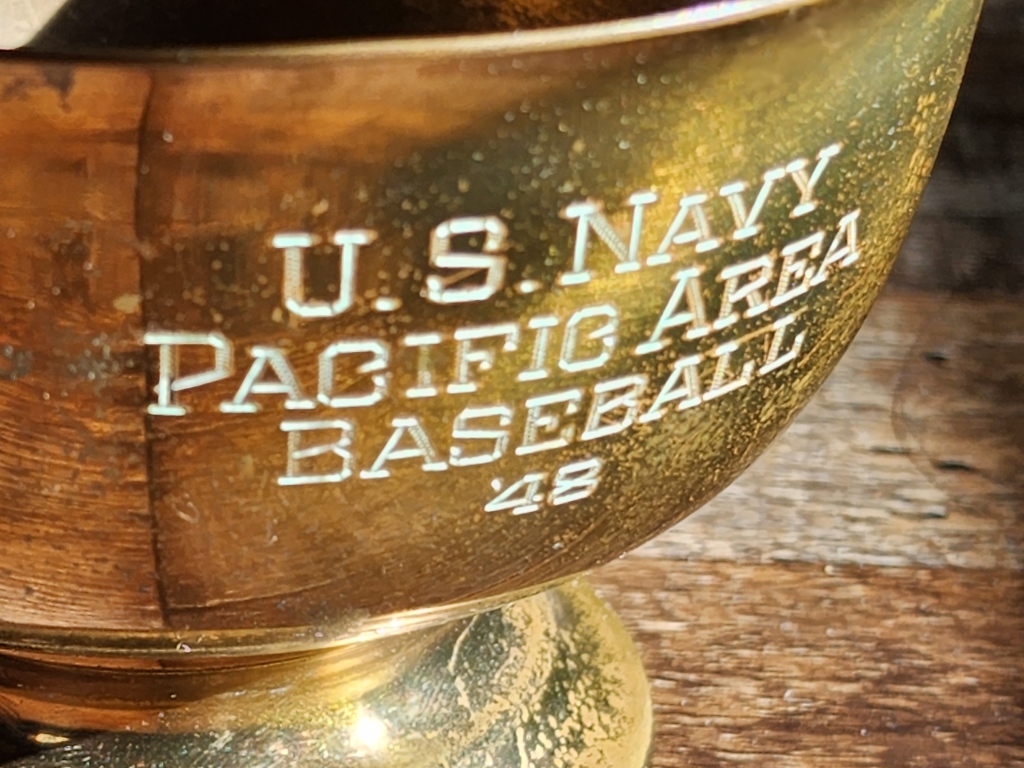

Leave a comment